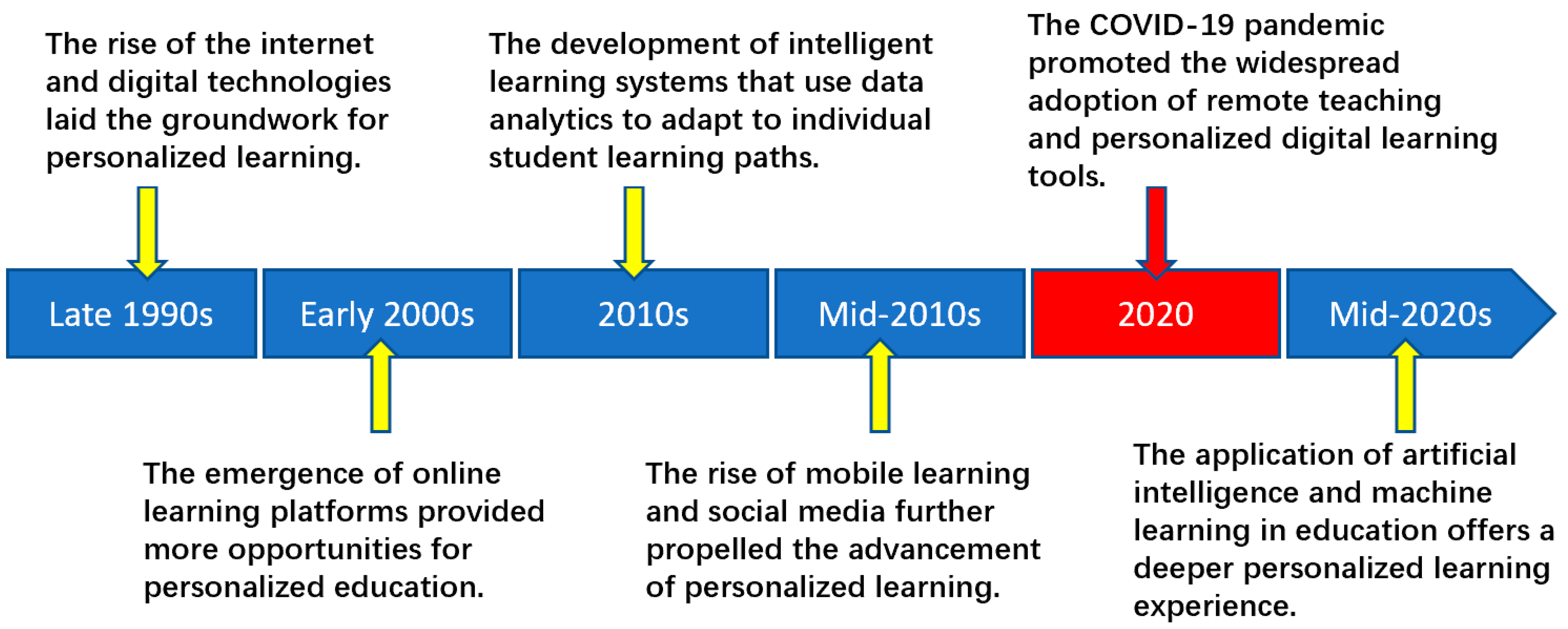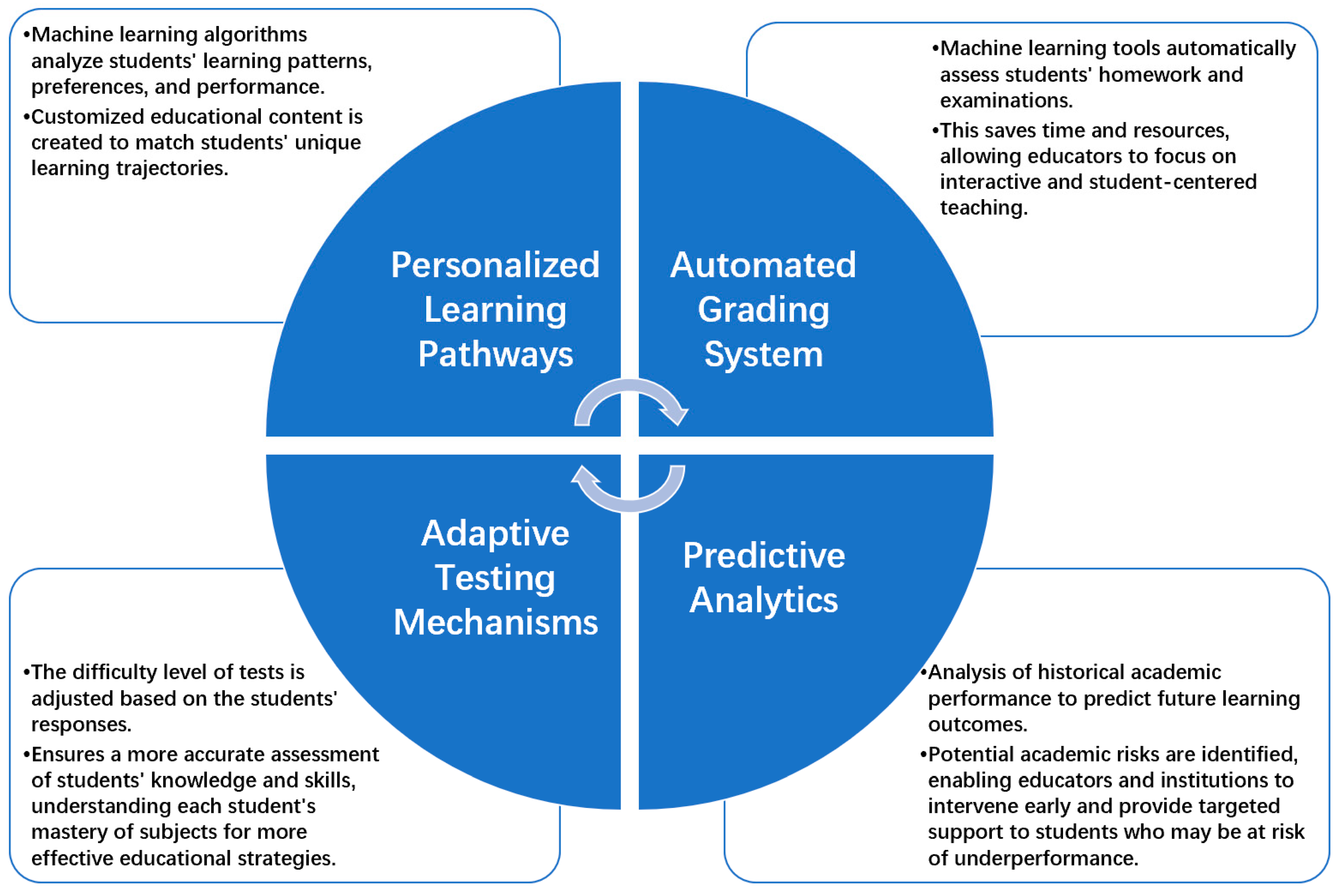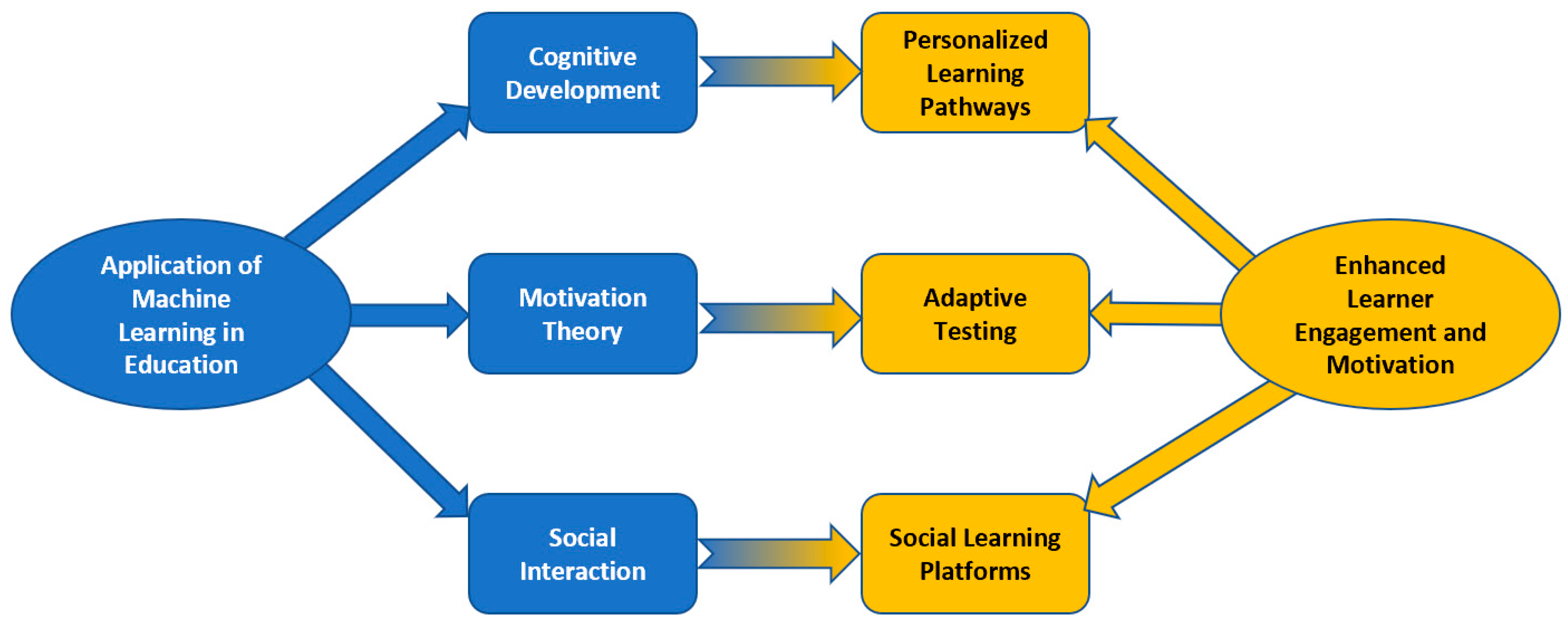Implementing the Dynamic Feedback-Driven Learning Optimization Framework: A Machine Learning Approach to Personalize Educational Pathways
Abstract
1. Introduction
1.1. Background of Personalized Education in the Digital Era
1.2. The Evolution and Impact of Machine Learning in Education
1.3. Brief Overview of the Paper
1.4. Objectives and Contributions of the Study
1.5. Addressing the Research Gap
2. Literature Review
2.1. Applications of Machine Learning in Educational Settings
2.2. Theoretical Underpinnings of Personalized Learning
2.3. Previous Studies on Adaptive Learning Systems
2.4. Identifying Gaps in Current Personalized Learning Research
2.5. Direct Relevance of Cited Works to Our Research
2.6. Critical Examination of Theories in Personalized Learning
3. Theoretical Framework
3.1. Cognitive Theories in Learning
3.1.1. Cognitive Development and Learning Acquisition
3.1.2. Application of Cognitive Strategies in Learning
3.1.3. Cognitive Load and Learning Processing
3.2. Educational Psychology Theories Related to Machine Learning
3.2.1. Machine Learning in Enhancing Learner Engagement
3.2.2. Motivational Aspects in Machine Learning-Based Environments
3.2.3. Collaborative Learning and Social Interaction in Machine Learning Contexts
3.3. Bridging Theoretical Concepts with Practical Application in DFDLOF
4. Implementation of DFDLOF in Personalizing Educational Pathways
4.1. Framework Architecture and Components
4.1.1. Overview of the DFDLOF Model
4.1.2. Key components and their functionalities
4.2. Integration of Machine Learning Algorithms
4.2.1. Selection and Application of Machine Learning Algorithms
4.2.2. Data Processing and Pattern Recognition
4.2.3. Selection Criteria and Rationale for Machine Learning Algorithms in DFDLOF
4.3. Adaptive Learning Pathway Design
4.3.1. Customizing Learning Content Based on Learner Profiles
4.3.2. Dynamic Adjustment of Learning Paths and Difficulty Levels
5. Case Studies
5.1. Case Study One: Khan Academy
5.1.1. Detailed Description of Khan Academy
5.1.2. Application of DFDLOF in Khan Academy
5.1.3. Insights and Implications from Khan Academy
5.1.4. Reflective Outcomes from Khan Academy Case Study
5.2. Case Study Two: Coursera
5.2.1. Overview of Coursera
5.2.2. Comparison with Khan Academy
5.2.3. Application of DFDLOF in Coursera
5.2.4. Insightful Observations from Coursera Implementation
6. Discussion
6.1. Strengths and Limitations of the DFDLOF Framework
6.1.1. Strengths
6.1.2. Limitations
6.2. Implications for Educators and Developers
6.2.1. For Educators
6.2.2. For Developers
6.2.3. Future Trends
6.3. Interpreting Results within the Context of Existing Literature
7. Conclusion
7.1. Summary of Key Findings
7.2. Directions for Future Research
7.3. Practical Implications, Limitations, and Future Research Directions
Author Contributions
Funding
Institutional Review Board Statement
Informed Consent Statement
Data Availability Statement
Conflicts of Interest
References
- Rodney, B.D. Understanding the paradigm shift in education in the twenty-first century: The role of technology and the Internet of Things. Worldw. Hosp. Tour. Themes 2020, 12, 35–47. [Google Scholar] [CrossRef]
- Klašnja-Milićević, A.; Ivanović, M. E-learning personalization systems and sustainable education. Sustainability 2021, 13, 6713. [Google Scholar] [CrossRef]
- Liu, D.Y.T.; Bartimote-Aufflick, K.; Pardo, A.; Bridgeman, A.J. Data-driven personalization of student learning support in higher education. In Learning Analytics: Fundaments, Applications, and Trends; Springer: Berlin/Heidelberg, Germany, 2017; pp. 143–169. [Google Scholar] [CrossRef]
- Bhutoria, A. Personalized education and artificial intelligence in the United States, China, and India: A systematic review using a human-in-the-loop model. Comput. Educ. Artif. Intell. 2022, 3, 100068. [Google Scholar] [CrossRef]
- De Freitas, S.; Gibson, D.; Du Plessis, C.; Halloran, P.; Williams, E.; Ambrose, M.; Dunwell, I.; Arnab, S. Foundations of dynamic learning analytics: Using university student data to increase retention. Brit J. Educ. Technol. 2015, 46, 1175–1188. [Google Scholar] [CrossRef]
- Deng, L.; Li, X. Machine learning paradigms for speech recognition: An overview. IEEE/ACM Trans. Audio Speech Lang. Process. 2013, 21, 1060–1089. [Google Scholar] [CrossRef]
- Arthars, N.; Dollinger, M.; Vigentini, L.; Liu, D.Y.T.; Kondo, E.; King, D.M. Empowering Teachers to Personalize Learning Support. In Utilizing Learning Analytics to Support Study Success, 2nd ed.; Ifenthaler, D., Mah, D.K., Yau, J.Y.K., Eds.; Springer: Cham, Switzerland, 2019; pp. 154–196. [Google Scholar] [CrossRef]
- Korkmaz, C.; Correia, A.P. A review of research on machine learning in educational technology. Educ. Media Int. 2019, 56, 250–267. [Google Scholar] [CrossRef]
- Supraja, N.; Prasad, T.; Krishna, T.G.; David, E. Synthesis, characterization, and evaluation of the antimicrobial efficacy of Boswellia ovalifoliolata stem bark-extract-mediated zinc oxide nanoparticles. Appl. Nanosci. 2016, 6, 581–590. [Google Scholar] [CrossRef]
- Raj, N.S.; Renumol, V.G. A systematic literature review on adaptive content recommenders in personalized learning environments from 2015 to 2020. J. Comput. Educ. 2022, 9, 113–148. [Google Scholar] [CrossRef]
- Huizhong, Z.; Fanrong, M.; Gui, W.; Mago, B.; Puyalnithi, T. Research on the automation integration terminal of the education management platform based on big data analysis. Adv. Data Sci. Adapt. 2022, 14, 2250003. [Google Scholar] [CrossRef]
- Chen, K.; Zhai, X.; Sun, K.; Wang, H.; Yang, C.; Li, M. A narrative review of machine learning as promising revolution in clinical practice of scoliosis. Ann. Transl. Med. 2021, 9. [Google Scholar] [CrossRef]
- Da Costa, O.; Warnke, P.; Cagnin, C.; Scapolo, F. The impact of foresight on policy-making: Insights from the FORLEARN mutual learning process. Technol. Anal. Strateg. 2008, 20, 369–387. [Google Scholar] [CrossRef]
- Martin, A.J.; Lazendic, G. Computer-adaptive testing: Implications for students’ achievement, motivation, engagement, and subjective test experience. J. Educ. Psychol. 2018, 110, 27. [Google Scholar] [CrossRef]
- Gresse von Wangenheim, C.; Hauck, J.C.; Pacheco, F.S.; Bertonceli Bueno, M.F. Visual tools for teaching machine learning in K-12: A ten-year systematic mapping. Educ. Inf. Technol. 2021, 26, 5733–5778. [Google Scholar] [CrossRef] [PubMed]
- Bernacki, M.L.; Greene, M.J.; Lobczowski, N.G. A systematic review of research on personalized learning: Personalized by whom, to what, how, and for what purpose(s)? Educ. Psychol. Rev. 2021, 33, 1675–1715. [Google Scholar] [CrossRef]
- Lewis, T.; Vialleton, E. The notions of control and consciousness in learner autonomy and self-regulated learning: A comparison and critique. Innov. Lang. Learn. Teach. 2011, 5, 205–219. [Google Scholar] [CrossRef]
- Kardan, A.A.; Aziz, M.; Shahpasand, M. Adaptive systems: A content analysis on technical side for e-learning environments. Artif. Intell. Rev. 2015, 44, 365–391. [Google Scholar] [CrossRef]
- El-Sabagh, H.A. Adaptive e-learning environment based on learning styles and its impact on development students’ engagement. Int. J. Educ. Technol. High. Educ. 2021, 18, 53. [Google Scholar] [CrossRef]
- Martin, F.; Chen, Y.; Moore, R.L.; Westine, C.D. Systematic review of adaptive learning research designs, context, strategies, and technologies from 2009 to 2018. Educ. Technol. Res. Dev. 2020, 68, 1903–1929. [Google Scholar] [CrossRef]
- Ainscow, M. Developing inclusive education systems: What are the levers for change? J. Educ. Chang. 2005, 6, 109–124. [Google Scholar] [CrossRef]
- Zhang, L.; Basham, J.D.; Yang, S. Understanding the implementation of personalized learning: A research synthesis. Educ. Res. Rev. 2020, 31, 100339. [Google Scholar] [CrossRef]
- Zheng, L.; Long, M.; Zhong, L.; Gyasi, J.F. The effectiveness of technology-facilitated personalized learning on learning achievements and learning perceptions: A meta-analysis. Educ. Inf. Technol. 2022, 27, 11807–11830. [Google Scholar] [CrossRef]
- Tzimas, D.; Demetriadis, S. Ethical issues in learning analytics: A review of the field. Educ. Technol. Res. Dev. 2021, 69, 1101–1133. [Google Scholar] [CrossRef]
- Hew, K.F.; Brush, T. Integrating technology into K-12 teaching and learning: Current knowledge gaps and recommendations for future research. Educ. Technol. Res. Dev. 2007, 55, 223–252. [Google Scholar] [CrossRef]
- Rutter, M. Family and school influences on cognitive development. J. Child. Psychol. Psychiatry 1985, 26, 683–704. [Google Scholar] [CrossRef] [PubMed]
- Stein, D.J. Schemas in the cognitive and clinical sciences: An integrative construct. J. Psychother. Integr. 1992, 2, 45. Available online: https://psycnet.apa.org/doi/10.1037/h0101236 (accessed on 3 December 2023). [CrossRef]
- Hausfather, S.J. Vygotsky and schooling: Creating a social context for learning. Action. Teach. Educ. 1996, 18, 1–10. [Google Scholar] [CrossRef]
- Winn, A.S.; DelSignore, L.; Marcus, C.; Chiel, L.; Freiman, E.; Stafford, D.; Newman, L. Applying cognitive learning strategies to enhance learning and retention in clinical teaching settings. Mededportal J. Teach. Learn. Resour. 2019, 15, 10850. [Google Scholar] [CrossRef]
- Zarrabi, F. Investigating the relationship between learning style and metacognitive listening awareness. Int. J. Listen. 2020, 34, 21–33. [Google Scholar] [CrossRef]
- Sweller, J. Cognitive load theory and educational technology. Educ. Technol. Res. Dev. 2020, 68, 1–16. [Google Scholar] [CrossRef]
- Yang, T.C.; Hwang, G.J.; Yang, S.J.H. Development of an adaptive learning system with multiple perspectives based on students’ learning styles and cognitive styles. J. Educ. Technol. Soc. 2013, 16, 185–200. Available online: http://www.jstor.org/stable/jeductechsoci.16.4.185 (accessed on 5 December 2023).
- Bhardwaj, P.; Gupta, P.K.; Panwar, H.; Siddiqui, M.K.; Morales-Menendez, R.; Bhaik, A. Application of deep learning on student engagement in e-learning environments. Comput. Electr. Eng. 2021, 93, 107277. [Google Scholar] [CrossRef] [PubMed]
- Michael, C.J.; Acklin, D.; Scheuerman, J. On interactive machine learning and the potential of cognitive feedback. arXiv 2020, arXiv:2003.10365. [Google Scholar] [CrossRef]
- Moubayed, A.; Injadat, M.; Nassif, A.B.; Lutfiyya, H.; Shami, A. E-learning: Challenges and research opportunities using machine learning & data analytics. IEEE Access 2018, 6, 39117–39138. [Google Scholar] [CrossRef]
- Maghsudi, S.; Lan, A.; Xu, J.; van der Schaar, M. Personalized education in the artificial intelligence era: What to expect next. IEEE Signal Process. Mag. 2021, 38, 37–50. [Google Scholar] [CrossRef]
- Kreijns, K.; Kirschner, P.A.; Jochems, W. Identifying the pitfalls for social interaction in computer-supported collaborative learning environments: A review of the research. Comput. Hum. Behav. 2003, 19, 335–353. [Google Scholar] [CrossRef]
- Vassileva, J. Toward social learning environments. IEEE Trans. Learn. Technol. 2008, 1, 199–214. [Google Scholar] [CrossRef]
- Peng, H.; Ma, S.; Spector, J.M. Personalized adaptive learning: An emerging pedagogical approach enabled by a smart learning environment. Smart Learn. Environ. 2019, 6, 9. [Google Scholar] [CrossRef]
- Li, K.C.; Wong, B.T.M. The use of student response systems with learning analytics: A review of case studies (2008–2017). Int. J. Mob. Learn. Organ. 2020, 14, 63–79. [Google Scholar] [CrossRef]
- El Aissaoui, O.; El Madani, Y.E.A.; Oughdir, L.; EL Allioui, Y. Combining supervised and unsupervised machine learning algorithms to predict the learners’ learning styles. Procedia Comput. Sci. 2019, 148, 87–96. [Google Scholar] [CrossRef]
- Tetzlaff, L.; Schmiedek, F.; Brod, G. Developing personalized education: A dynamic framework. Educ. Psychol. Rev. 2021, 33, 863–882. [Google Scholar] [CrossRef]
- Thurlings, M.; Vermeulen, M.; Bastiaens, T.; Stijnen, S. Understanding feedback: A learning theory perspective. Educ. Res. Rev. 2013, 9, 1–15. [Google Scholar] [CrossRef]
- Kokoç, M.; Altun, A. Effects of learner interaction with learning dashboards on academic performance in an e-learning environment. Behav. Inform. Technol. 2021, 40, 161–175. [Google Scholar] [CrossRef]
- Yaqoob, A.; Bi, T.; Muntean, G.M. A survey on adaptive 360 video streaming: Solutions, challenges and opportunities. IEEE Commun. Surv. Tut. 2020, 22, 2801–2838. [Google Scholar] [CrossRef]
- Shafiq, M.; Tian, Z.; Sun, Y.; Du, X.; Guizani, M. Selection of effective machine learning algorithm and Bot-IoT attacks traffic identification for internet of things in smart city. Future Gener. Comput. Syst. 2020, 107, 433–442. [Google Scholar] [CrossRef]
- Li, H. Deep learning for natural language processing: Advantages and challenges. Natl. Sci. Rev. 2018, 5, 24–26. [Google Scholar] [CrossRef]
- Dejaeger, K.; Goethals, F.; Giangreco, A.; Mola, L.; Baesens, B. Gaining insight into student satisfaction using comprehensible data mining techniques. Eur. J. Oper. Res. 2012, 218, 548–562. [Google Scholar] [CrossRef]
- Plasencia, A.; Navas, N. MOOCs, the Flipped Classroom, and Khan Academy Practices: The Implications of Augmented Learning. In Innovation and Teaching Technologies; Peris-Ortiz, M., Garrigós-Simón, F., Gil Pechuán, I., Eds.; Springer: Cham, Switzerland, 2014; pp. 1–10. [Google Scholar] [CrossRef]
- Vanbecelaere, S.; Van Schoors, R.; Bhatt, S.; Rajagopal, K.; Debeer, D.; Depaepe, F. Evaluating teachers’ perceptions and use of a portal for digital personalised learning: A multiple case study in Flanders. Educ. Inf. Technol. 2023, 22, 1–34. [Google Scholar] [CrossRef]
- Guan, C.; Mou, J.; Jiang, Z. Artificial intelligence innovation in education: A twenty-year data-driven historical analysis. Int. J. Innov. Stud. 2020, 4, 134–147. [Google Scholar] [CrossRef]
- Kinnebrew, J.S.; Segedy, J.R.; Biswas, G. Integrating model-driven and data-driven techniques for analyzing learning behaviors in open-ended learning environments. IEEE Trans. Learn. Technol. 2015, 10, 140–153. [Google Scholar] [CrossRef]




| Theory | Contribution to Personalized Learning |
|---|---|
| Constructivist Theory | Emphasizes active learning where learners build upon existing knowledge; underscores the need for learning experiences tailored to individual cognitive structures. |
| Cognitive Load Theory | Advocates for instructional designs optimized for cognitive resources; aims to balance content complexity and pacing to suit individual learner capacities. |
| Theory of Multiple Intelligences | Suggests varied strengths and learning preferences (linguistic, logical, spatial, kinesthetic, etc.); involves creating diverse learning pathways catering to these intelligences. |
| Zone of Proximal Development (ZPD) | Proposes optimal learning occurs in tasks that are achievable with appropriate guidance; personalized learning adjusts task difficulty to remain within the learner’s ZPD. |
| Self-Regulated Learning | Highlights the importance of learner autonomy and motivation; personalized learning environments empower learners to control their learning journey. |
| Study Reference | Key Contributions to Adaptive Learning |
|---|---|
| Baker et al. | Investigated the effects of adaptive learning technologies in online courses, demonstrating improvements in student engagement and performance. |
| Knewton | Provided a case study on adaptive learning in higher education, showing enhanced personalized learning experiences and academic outcomes. |
| Woolf | Explored the use of adaptive learning systems in K-12 education, revealing positive impacts on individualized instruction and student motivation. |
| Pardos and Heffernan | Examined the application of machine learning techniques in adaptive education systems, emphasizing their effectiveness in improving student learning paths. |
| Graf et al. | Analyzed the use of adaptive systems in facilitating different learning styles, leading to better accommodation of individual learner needs. |
| Machine Learning Algorithm | Contribution to Personalized Learning |
|---|---|
| Supervised Learning Algorithms | Used for predictive analytics; help forecast student performance and identify those needing additional support. |
| Unsupervised Learning Algorithms (e.g., Clustering) | Employed for content recommendation and personalization; group students based on preferences and achievements to create individual learning paths. |
| Reinforcement Learning | Vital in adjusting learning pathways post-student interaction; learns and adapts to improve learning experience based on feedback. |
| Deep Learning Strategies | Effective in processing natural language and complex decision making; analyze unstructured data to understand subtle details of student behaviors and preferences. |
| Feature/Aspect | Khan Academy | Coursera |
|---|---|---|
| Target Audience | K-12 students, focusing on fundamental subjects | Adult learners, higher education, and professional development |
| Learning Approach | Mastery-based learning, self-paced | Structured, time-bound courses emulating traditional higher education |
| Personalization Strategy | Personalized content based on individual learner’s performance and progression | Customized course offerings and paths tailored to adult learners’ professional and academic goals |
| Adaptation Mechanism | Real-time content and teaching method adjustments based on learner analytics | Flexibility in course structure and assessment methods, adapting to learners’ needs in a more structured environment |
| Feedback and Assessment | Dynamic, personalized feedback and adaptive assessments | Real-time feedback mechanisms tailored to individual learning progress |
| Aspect | Strengths or Limitations | Example/Analysis |
|---|---|---|
| Adaptability | Strength | Dynamically adapts learning content to individual needs, enhancing engagement and outcomes. |
| Data-Driven Approach | Strength | Provides insights into learning patterns, enabling informed decisions in curriculum design. |
| Real-Time Feedback | Strength | Offers immediate response to learner inputs, correcting misconceptions and supporting continuous learning. |
| Integration Complexity | Limitation | Challenging to integrate into existing educational infrastructures due to data and expertise requirements. |
| Data Privacy and Security | Limitation | Heavy reliance on learner data raises concerns about data security and ethical use. |
| Applicability in Diverse Contexts | Limitation | Effectiveness in diverse cultural and socio-economic settings needs further exploration for broader applicability. |
Disclaimer/Publisher’s Note: The statements, opinions and data contained in all publications are solely those of the individual author(s) and contributor(s) and not of MDPI and/or the editor(s). MDPI and/or the editor(s) disclaim responsibility for any injury to people or property resulting from any ideas, methods, instructions or products referred to in the content. |
© 2024 by the authors. Licensee MDPI, Basel, Switzerland. This article is an open access article distributed under the terms and conditions of the Creative Commons Attribution (CC BY) license (https://creativecommons.org/licenses/by/4.0/).
Share and Cite
Song, C.; Shin, S.-Y.; Shin, K.-S. Implementing the Dynamic Feedback-Driven Learning Optimization Framework: A Machine Learning Approach to Personalize Educational Pathways. Appl. Sci. 2024, 14, 916. https://doi.org/10.3390/app14020916
Song C, Shin S-Y, Shin K-S. Implementing the Dynamic Feedback-Driven Learning Optimization Framework: A Machine Learning Approach to Personalize Educational Pathways. Applied Sciences. 2024; 14(2):916. https://doi.org/10.3390/app14020916
Chicago/Turabian StyleSong, Chuanxiang, Seong-Yoon Shin, and Kwang-Seong Shin. 2024. "Implementing the Dynamic Feedback-Driven Learning Optimization Framework: A Machine Learning Approach to Personalize Educational Pathways" Applied Sciences 14, no. 2: 916. https://doi.org/10.3390/app14020916
APA StyleSong, C., Shin, S.-Y., & Shin, K.-S. (2024). Implementing the Dynamic Feedback-Driven Learning Optimization Framework: A Machine Learning Approach to Personalize Educational Pathways. Applied Sciences, 14(2), 916. https://doi.org/10.3390/app14020916






